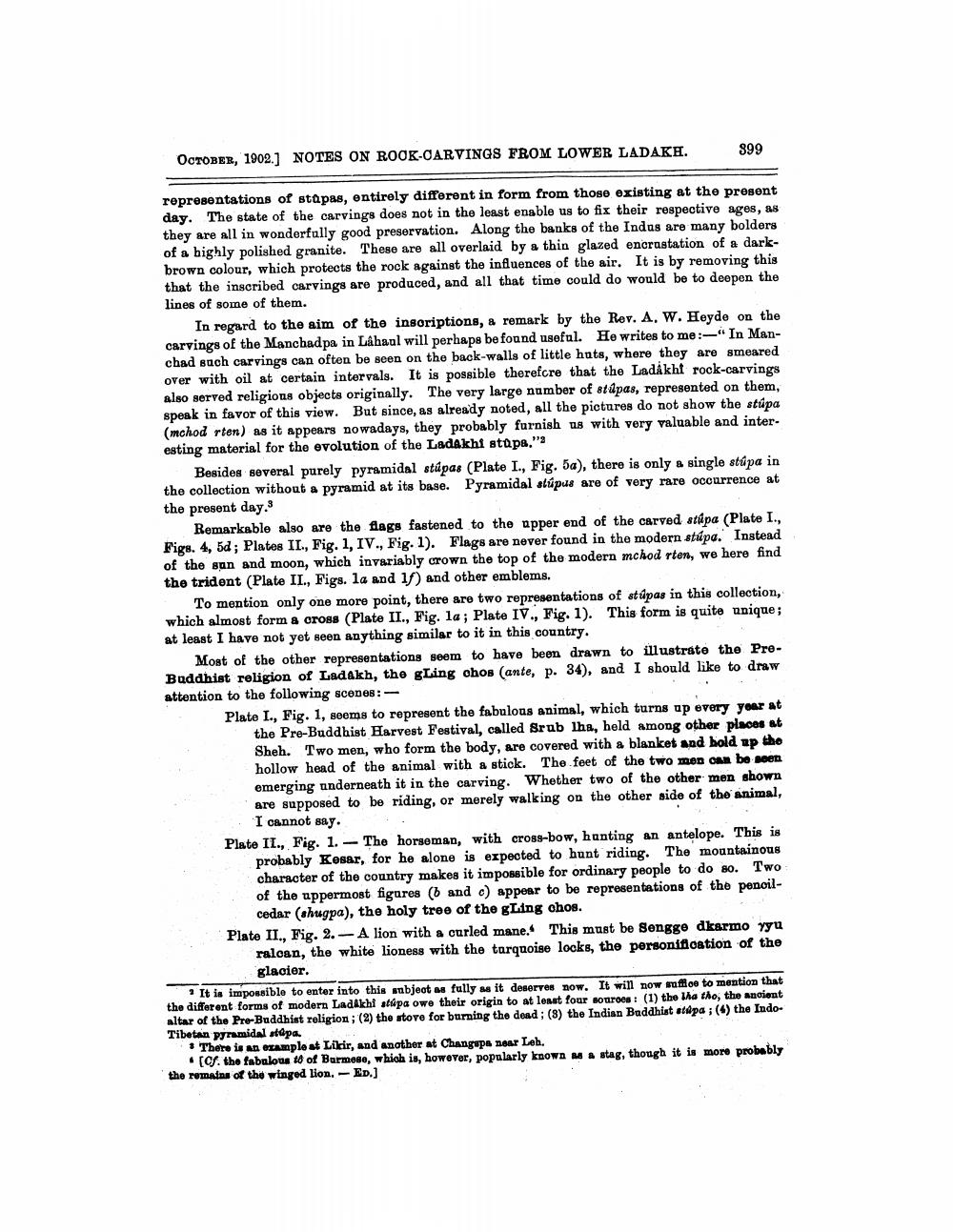________________
899
OCTOBER, 1902.] NOTES ON ROOK-CARVINGS FROM LOWER LADAKH.
representations of stapas, entirely different in form from those existing at the present day. The state of the carvings does not in the least enable us to fix their respective ages, as they are all in wonderfully good preservation. Along the banks of the Indus are many bolders of a highly polished granite. These are all overlaid by a thin glazed encrustation of a darkbrown colour, which protects the rock against the influences of the air. It is by removing this that the inscribed carvings are produced, and all that time could do would be to deepen the lines of some of them.
In regard to the aim of the inscriptions, a remark by the Rev. A. W. Heyde on the carvings of the Manchadpa in Lâhaul will perhaps be found useful. He writes to me:-" In Manchad such carvings can often be seen on the back-walls of little huts, where they are smeared over with oil at certain intervals. It is possible therefcre that the Ladakht rock-carvings also served religions objects originally. The very large number of stupas, represented on them, speak in favor of this view. But since, as already noted, all the pictures do not show the stúpa (mchod rten) as it appears nowadays, they probably furnish us with very valuable and interesting material for the evolution of the Ladakhi stupa.""
Besides several purely pyramidal stúpas (Plate I., Fig. 5a), there is only a single stúpa in the collection without a pyramid at its base. Pyramidal stúpus are of very rare occurrence at the present day.3
Remarkable also are the flags fastened to the upper end of the carved stúpa (Plate I., Figs. 4, 5d; Plates II., Fig. 1, IV., Fig. 1). Flags are never found in the modern stúpa. Instead of the sun and moon, which invariably crown the top of the modern mchod rten, we here find the trident (Plate II., Figs. 1a and 1f) and other emblems.
To mention only one more point, there are two representations of stupas in this collection, which almost form a cross (Plate II., Fig. 1a; Plate IV., Fig. 1). This form is quite unique; at least I have not yet seen anything similar to it in this country.
Most of the other representations seem to have been drawn to illustrate the PreBuddhist religion of Ladakh, the gLing chos (ante, p. 34), and I should like to draw attention to the following scenes:
Plate I., Fig. 1, seems to represent the fabulous animal, which turns up every year at
the Pre-Buddhist Harvest Festival, called Srub lha, held among other places at Sheh. Two men, who form the body, are covered with a blanket and hold up the hollow head of the animal with a stick. The feet of the two men can be seen emerging underneath it in the carving. Whether two of the other men shown are supposed to be riding, or merely walking on the other side of the animal, I cannot say.
Plate II., Fig. 1. The horseman, with cross-bow, hunting an antelope. This is probably Kesar, for he alone is expected to hunt riding. The mountainous character of the country makes it impossible for ordinary people to do so. Two of the uppermost figures (b and c) appear to be representations of the pencilcedar (shugpa), the holy tree of the gLing chos.
Plate II., Fig. 2.-A lion with a curled mane. This must be Sengge dkarmo yyu ralcan, the white lioness with the turquoise locks, the personification of the glacier.
2 It is impossible to enter into this subject as fully as it deserves now. It will now suffice to mention that the different forms of modern Ladakhi stúpa owe their origin to at least four sources: (1) the tha tho, the ancient altar of the Pre-Buddhist religion; (2) the stove for burning the dead; (3) the Indian Baddhist stúpa ; (4) the IndoTibetan pyramidal stúpa.
There is an example at Likir, and another at Changupa near Leh.
[Cf. the fabulous to of Burmese, which is, however, popularly known as a stag, though it is more probably the remains of the winged lion. - ED.]




